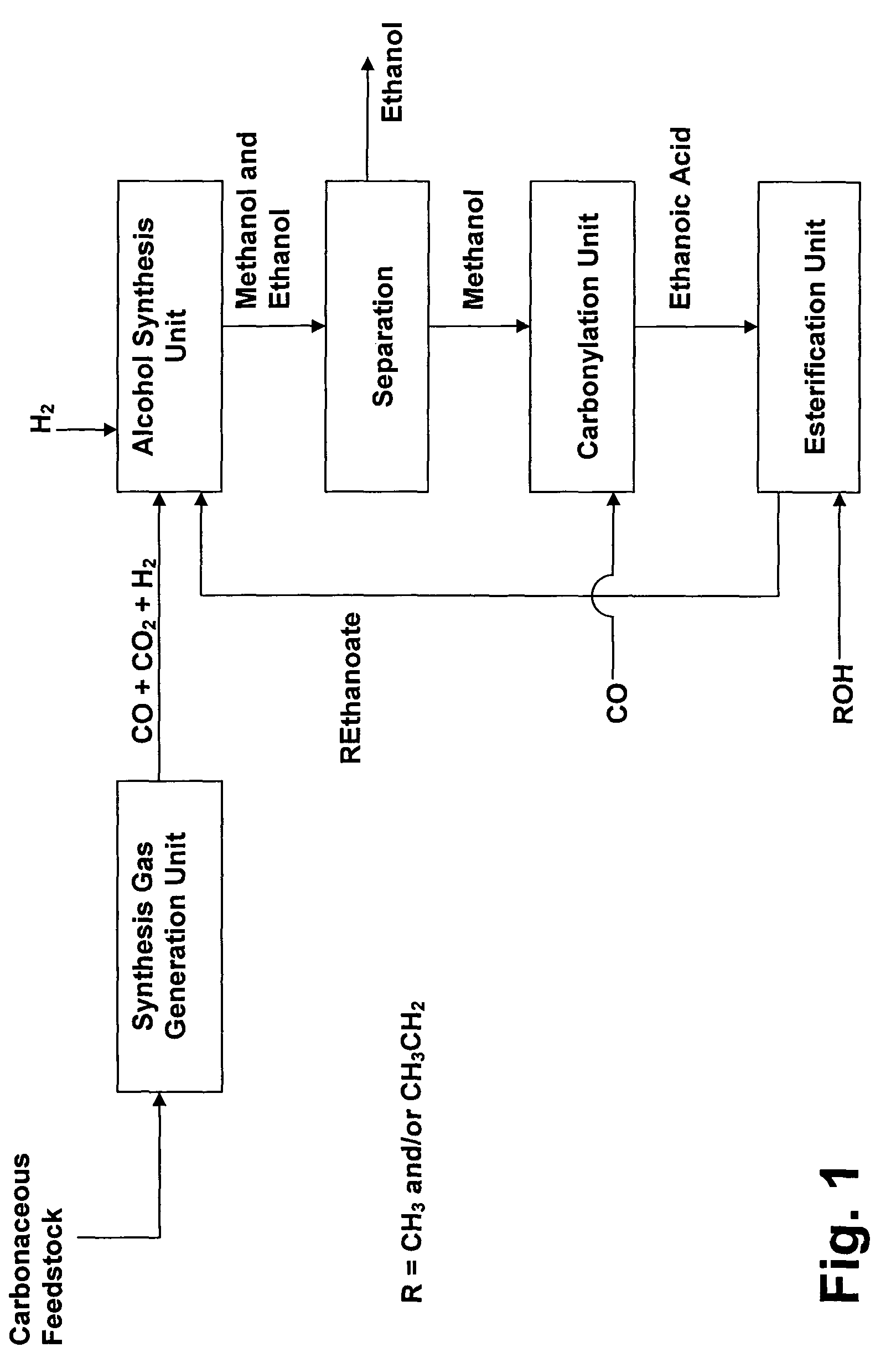Process for the conversion of hydrocarbons into ethanol
a technology of hydrocarbons and ethanol, which is applied in the field of hydrocarbons conversion into ethanol, can solve the problems of high pressure and limited equilibrium of methanol, and achieve the effects of increasing the formation of inert materials, and increasing the purge step
- Summary
- Abstract
- Description
- Claims
- Application Information
AI Technical Summary
Benefits of technology
Problems solved by technology
Method used
Image
Examples
example 1
[0136]A mixture of H2 (70 vol %), CO (10 vol %), methyl ethanoate (4 vol %) and N2 (16 vol %) was passed over T-2130 at 240° C., with a pressure of 7.6 MPa and a GHSV of 6837 h−1 for 20 h; the LHSV was 1.0 h−1. The observed conversion of methyl ethanoate was 96.7% and the selectivity to ethyl products (i.e. ethanol and the ethyl portion of ethyl ethanoate) was 97.9%. In this Example, methanol was produced from CO hydrogenation and methyl ethanoate hydrogenolysis. The ratio of methanol to converted methyl ethanoate was 2.24 (on a molar basis).
example 2
[0137]A mixture of H2 (70 vol %), CO (10 vol %), methyl ethanoate (4 vol %) and N2 (16 vol %) was passed over T-2130 at 250° C., with a pressure of 7.6 MPa and a GHSV of 6837 h−1 for 20 h; the LHSV was 1.0 h−1. The observed conversion of methyl ethanoate was 96.2% and the selectivity to ethyl products (i.e. ethanol and the ethyl portion of ethyl ethanoate) was 95.7%. In this Example, methanol was produced from CO hydrogenation and methyl ethanoate hydrogenolysis. The ratio of methanol to converted methyl ethanoate was 2.40 (on a molar basis).
example 3
[0138]A mixture of H2 (70 vol %), CO (10 vol %), CO2 (10 vol %), methyl ethanoate (4 vol %) and N2 (6 vol %) was passed over T-2130 at 250° C., with a pressure of 7.6 MPa and a GHSV of 6837 h−1 for 20 h; the LHSV was 1.0 h−1. The observed conversion of methyl ethanoate was 95.1% and the selectivity to ethyl products (i.e. ethanol and the ethyl portion of ethyl ethanoate) was 98.6%. In this Example, methanol was produced from CO hydrogenation and methyl ethanoate hydrogenolysis. The ratio of methanol to converted methyl ethanoate was 3.11 (on a molar basis).
PUM
| Property | Measurement | Unit |
|---|---|---|
| Temperature | aaaaa | aaaaa |
| Temperature | aaaaa | aaaaa |
| Temperature | aaaaa | aaaaa |
Abstract
Description
Claims
Application Information
 Login to View More
Login to View More - R&D
- Intellectual Property
- Life Sciences
- Materials
- Tech Scout
- Unparalleled Data Quality
- Higher Quality Content
- 60% Fewer Hallucinations
Browse by: Latest US Patents, China's latest patents, Technical Efficacy Thesaurus, Application Domain, Technology Topic, Popular Technical Reports.
© 2025 PatSnap. All rights reserved.Legal|Privacy policy|Modern Slavery Act Transparency Statement|Sitemap|About US| Contact US: help@patsnap.com

